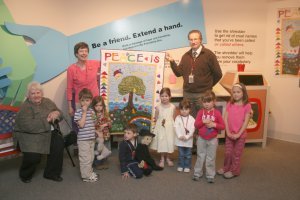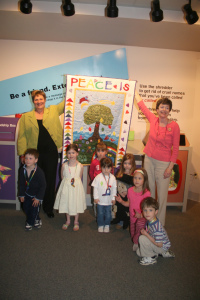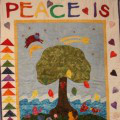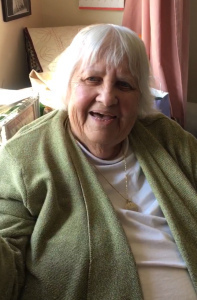K.D. Dowdall's Blog, page 33
August 1, 2018
The Legacy of Milly, Part 4
Posted on July 14, 2018by Jennie
In Part 3, Milly brought in beautiful fabrics and placed them on the sketch of the Peace Quilt spread out across a big table. Children came to her like moths to a candle, picking out just the right fabrics. At last the quilt was completed, and it was a work of art. We wrote a poetry book and the quilt was big news in town. I told ‘the world’, including the director of the National Liberty Museum.
Part 4
“Jennie, thank you for telling us about the quilt. I’m sure it is as stunning as your Peace Peace Portal” said the museum director.” That was so nice! She then continued.
“I want to tell you that the museum would like the Peace Quilt. We want it as part of our permanent display.”
I was shocked. And here, I’d just wanted them to know all that had transpired since I saw their Peace Portal. I was thrilled. Then it sank in- a quilt from my classroom was going to be displayed – permanently – in a national museum. I couldn’t wait to tell Milly!
We talked, laughed, and enjoyed the moment. Milly was pleased as punch and just as taken aback as I was.
“Milly, you have done so much for us. You made this quilt. How can I ever thank you?”
Milly didn’t bat an eye. “Take me to Philadelphia” she said, with gusto.
Road Trip!
Children and families were eager to go and be part of presenting their work to a national museum. A good sized group made the trip to Philadelphia. The director had one request. “Please bring Gloria, too. After all, the quilt was her idea.” Yes, Gloria made the trip with us.
My husband and I picked up Milly at the crack of dawn. As the car went whispering along the highway in the early morning hours we chatted away. Milly leaned forward from the back seat, putting her arms and elbows up on the back of the front seat. She said, “I’m the other woman”, with a low voice and body language that meant she wanted to really talk about herself. What an icebreaker! She told us she’d long been separated and has a dear soulmate, another man. She told us that her daughter had died a few years ago from cancer, and how she’d spent every moment by her bedside, quilting. Her daughter had two young girls, and Milly was pretty much raising those girls, along with their dad. Milly talked about the quilting shop she had for years, and I learned about quilting clubs. She reminisced about life in the 1940’s. We laughed, we cried.
It was the most delightful six-hour drive. We became good friends.
The quilt presentation was exciting and humbling. We were treated like kings and queens. Milly was all smiles. Gloria never left Grant’s side. In the Part 3 photo, he and Gloria were checking out the quilt progress together.
The museum made a plaque to place underneath the quilt that reads:
“Peace Quilt” designed by students at the Groton Community School, Groton, Massachusetts. Their teacher, Ms. Jennie Fitzkee, conceived this project after visiting the National Liberty Museum two years ago. She saw many visions of peace displayed throughout the Museum, which made her wonder how her young students would interpret this concept. With the help of a beloved classroom puppet named “Gloria”, Ms. Fitzkee inspired the youngsters to draw their ideas of “Peace.” Quilter Milly Cunningham used their illustrations of rainbows, happy animals and even trucks to create this beautiful quilt. The National Liberty Museum is grateful to Ms. Fitzkee and her students for this wonderful gift.
And so, we reveled in all the glory on our car ride home. We shared stories and wrote thank you notes over the next few weeks. We were truly humbled. The rest of the school year Milly continued to come in to visit and play with the children. Her bond was a strong one. Children loved her. They wanted to be with her and play. I stood back and watched magic happen – every time she visited.
I sing all the time with children, often playing the autoharp. It’s a staple in my classroom. On one of Milly’s visits Gloria wanted to sing. We learned that Milly loves to sing! She joined us in a chorus of songs. Did you know that Milly’s favorite song is “God Bless America?” I did not. Well, the children were thrilled, as that is one of their favorite songs, too.
The school year ended, and the following year Milly was a frequent visitor. Something different happened that year. A group of children loved singing “God Bless America” and often begged for the song. “Jennie, can you play it on your autoharp so we can sing?” I did, yet I always played and sang many other songs as well. This was becoming big, and I respond to big when it comes from children. That means I had to do something, do more. I did! And it turned into a pathway I’d never expected. Thank goodness Milly was there… stay tuned for Part 5.
July 31, 2018
The Legacy of Milly, Part 3
https://jenniefitzkee.com/2018/07/10/the-legacy-of-milly-part-3
In Part2, Milly came onto the scene, meeting the children and Gloria. She accepted the “challenge” – as she called it – of quilting a mural which would become a Peace Quilt. Gloria started the ball rolling with her own blankie, actually her personal Peace Quilt.
Part 3
As I collected photos for this story, look what I found in my archives:
the original sketch!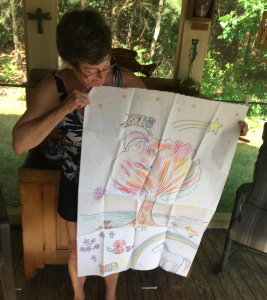
When the sketch was finished and children had decided that the quilt would be ‘just so’, they spent time coloring their design. This solidified their images of Peace and reinforced how they wanted the quilt to look. It was coming to life.
Milly came to school every week with fabrics. They were gorgeous! I asked her if she had purchased them at JoAnne Fabrics. Her silence was deafening. I compare this faux pas to asking a lady wearing an original Oscar de la…
View original post 645 more words
July 30, 2018
The Legacy of Milly, Part 2
Part 2 of The Legacy of Milly and the beginning of the design of the quilt with the children and Milly hard at work. This 7 Part true story series was a work of love for Jennie’s students and by Milly, a quilter extraordinary. As written by Jennie Fitzkee, https://jenniefitzkee.com/2018/07/06/the-legacy-of-milly-part-2/
In Part 1, I discovered a Peace Portal at a museum and recreated it in my classroom. Peace became a big deal and very real to children. When I saw quilts that were murals, I knew I had to make a Peace Quilt with children. The only problem was finding a quilter. At last I met Milly. It was an unexpected meeting.
Part 2
“Milly is the best quilter, not just in town but everywhere.” said the director of the Senior Center.
“Great! When can I stop by and meet her?”
“She’ll be here on Wednesday with her quilting group.”
Wednesday couldn’t come fast enough for me. As soon as school was over, I was there. I walked over to Milly and introduced myself. She smiled (sort of) and I bounced around, telling her all about the Haitian quilts I had seen at the Bennington Museum. I was so…
View original post 763 more words
July 29, 2018
The Legacy of Milly the Quilter- a Series of Stories
This is Milly, the Quilter.
Milly the quilter, a beloved friend to children in my classroom (and to me!) for ages, and the creator of many quilts designed by the children and hanging in places of prominence, has recently passed away. Her last words to me were, “Jennie, I am 88 years old. I have lived a wonderful life. What else is there?”
I will be posting a series of stories about Milly over the next few weeks. Her legacy needs to recognized. Her story, our story, is remarkable. Each quilt we created together was an adventure. So, hang onto your hats and enjoy the stories of Milly. Stay tuned for Part 1.
Jennie
The Legacy of Milly, Part 1
I am reblogging this 7 part story, one for each day, for those bloggers that may have missed this heartwarming, healing, and true story, that lead to a quilt being hung in the Foster House at the Boston VA Hospital for our soldiers, as designed by Jennie’s young students with the help of Milly, a quilter, to make a beautiful quilt.
Every good story has a great backstory. To know how Milly came into my life and tell you about her early years in my classroom, I have to back up and tell you what really happened. It’s a great story, and began what would become a legacy. Hang onto your hat!
“It happened like this…”
My husbabnd and I were at a fall wedding in Philadelphia. We had an hour to spare, and went to the historic district to visit Carpenters Hall. After the tour, we had ten or fifteen minutes until all the museums closed. Directly across the street was the National Liberty Museum, so we headed over. Walking into the museum I was thunderstruck by a magnificent Peace Portal. I stood underneath, soaking in all the beauty. The museum was closing, and I hadn’t moved from under the Peace Portal.
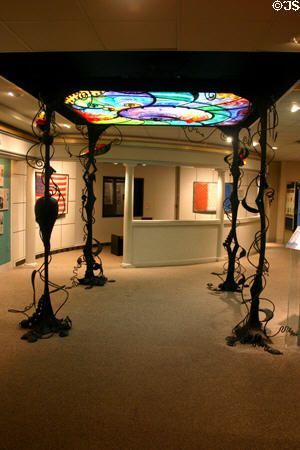
“I can do this!” I told my husband…
View original post 372 more words
Fiction Writing Exercises: Narrative Arcs
[image error]Fiction Writing Exercises: Narrative Arcs https://www.writingforward.com/wp-content/uploads/2018/07/fiction-writing-exercises-narrative-arcs.jpg by Melissa Donovan | Jul 19, 2018 | Fiction Writing Exercises | 0 comments
Fiction writing Exercise Narrative Arcs
Narrative arcs: a fiction writing exercise.
Today’s fiction writing exercise is an excerpt from my book, Story Drills: Fiction Writing Exercises. This one focuses on story structure and examines narrative arcs within stories and across multiple scenes and installments of a story. Enjoy!
Narrative Arcs
An arc has a beginning, a middle, and an end. The events within an arc result in some kind of change for the story world, characters, or direction of the plot.
In serial or episodic storytelling, a story arc is an ongoing story line that spans multiple installments. An arc might last through several episodes of a television show or several issues of a comic book. In literature, an arc might stretch across multiple books in a series.
A narrative arc (or dramatic arc) is similar to a story arc, except it doesn’t have to occur across multiple installments of episodic storytelling. A narrative arc is any arc within a story, including the central plot and any subplots. Narrative arcs can occur within a single scene or span across a sequence of scenes.
Characters also experience arcs when they undergo a progression of transformation.
That’s a lot of different types of arcs. To make matters more confusing, the terms for story arcs, narrative arcs, and dramatic arcs are often used interchangeably.
Study:
You can use any type of story for this exercise: books, comics, TV shows, or films. Find a series that you’ve enjoyed, and examine a small sample of installments. For example, you can look at five episodes from a TV show or three novels from a series. Make sure you’re using serials, which use ongoing stories across multiple installments, rather than episodic installments, which are separate but loosely connected.
Make a list of three to five story arcs found across the installments you examined. Do the arcs intertwine? Are they occurring simultaneously, or are they consecutive? How does each arc relate to the central plot?
Practice:
Create a set of three story arcs that would span multiple novels in a series. If you’re already working on a series, feel free to create arcs within your project.
For example, start by writing quick summaries of at least five novels in a series (about one paragraph each, highlighting the central plot of each installment). Then come up with the three arcs, each of which would span multiple novels.
As an alternative, you can develop ideas for a television or comic book series.
Questions:
What is the difference between a story arc and a dramatic arc? Why are story arcs effective in serial storytelling? How is a character arc different from a narrative arc? What types of arcs are most important in storytelling?
Fiction Writing Exercises: Narrative Arcs https://www.writingforward.com/wp-content/uploads/2018/07/fiction-writing-exercises-narrative-arcs.jpg
July 28, 2018
Another Haiku
I love this Haiku. It is beautifully philosophical, and heartfelt.
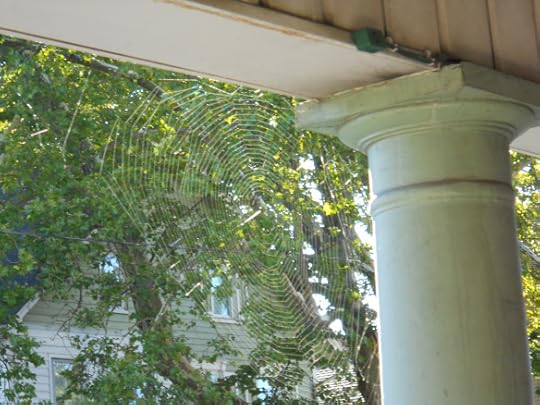
(Candid By Liz)
A web full of life
Spun emotions caught within
A magical thought
12 Book Marketing and Book Selling Goosers for Authors – by Judith Briles…
As writers, we can and do write really good books, but if no one sees them, especially if one is a Indie author, it is very sad indeed. We do need good strategies about marketing and thank you Judith!
 Chris The Story Reading Ape's Blog
Chris The Story Reading Ape's Blog
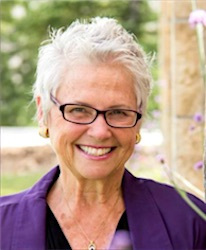
on The Book Shepherd:

We authors need to be strategic in how we market ourselves and our books. Period.
Bookselling is way beyond the bookstore—in fact, bookstores are minor players for the great majority of authors today–especially the independent, small press and self-published author.
Is there one true way to do market books? Nope, with the exception … do something–not just anything–something that the target marketing is receptive to. And that means YOU, the author need to do some homework.
Continue reading HERE
July 24, 2018
In Search of History
What an amazing look into history and is history repeating itself by President Trump’s dereliction of his oath of office to protect democracy?
 The key lesson of the 20th century is that democracy is far more fragile than we might think.
The key lesson of the 20th century is that democracy is far more fragile than we might think.Prior to WWII, fascist ideas were increasingly accepted. The energetic growth of Nazi organizations spread across America in the 1930’s. This appeal of fascists ideas were held by such prominent citizens as Henry Ford and Charles Lindbergh, who went so far as to praise Hitler.
At the time, Jews served the same role as immigrants and minorities do today. It was believed that Jews posed threats that were undermining America’s greatness. In 1942 a Gallup poll showed that a growing number of Americans thought Hitler was doing the “right thing” to Jews. This is similar to what many Americans think about what Trump is doing to immigrants and foreign minorities today: “the right thing”. While secure borders are critical to our national security, we need to keep in mind those who are…
View original post 43 more words
July 23, 2018
10 wonderful quotes about being a writer #amwriting #writer #writerslife
These quotes are so uplifting for writers and thank you for sharing them us. #I am writing!
“You fail only if you stop.”
~ Ray Bradbury
“This is what separates artists from ordinary people: the belief, deep in our hearts, that if we build our castles well enough, somehow the ocean won’t wash them away.”
~ Anne Lamott
“Every human being has hundreds of separate people living under his skin. The talent of a writer is his ability to give them their separate names, identities, personalities, and have them relate to other characters living with him.”
~ Mel Brooks
“Most people carry their demons around with them, buried down deep inside. Writers wrestle their demons to the surface, fling them out onto the page, then call them characters.”
~ C.K. Webb
“The more you leave out, the more you highlight what you leave in.”
~Henry Green
“Which of us has not felt that the character we are reading in the printed page is more real than the…
View original post 110 more words

